Monitoring and Evaluating Restoration Vegetation Status in Mine Region Using Remote Sensing Data: Case Study in Inner Mongolia, China
Abstract
1. Introduction
2. Study Area and Remote Sensing Images Collection
2.1. Study Area
2.2. Data Collection
3. Methods for Restoration Vegetation Monitoring and Evaluation
3.1. Vegetation Growth Monitoring Methods
3.1.1. Vegetation Index and Growth Monitoring Methods
3.1.2. The Estimated Method of the Land Cover Type Change (LTC) Factor
3.1.3. Annual Variation of Restoration Vegetation Growth
3.2. Evaluation Method of Restoration Vegetation Effects
3.2.1. Annual Restoration Vegetation Effect Factor E
3.2.2. Restoration Effect of Area-Average Factor EAA
3.2.3. The Comprehensive Restoration Effect Factor CE
4. Restoration Vegetation Monitoring and Evaluation Results
4.1. Inter-Annual Vegetation Growth Results and Cross-Validation
4.2. Land Type Change Results
4.3. Restoration Vegetation and Surrounding Natural Vegetation Growth
4.4. Growth of Restoration Vegetation with Different Restoration Beginning Years
4.5. Evaluation of Restoration Vegetation Effects
5. Conclusions and Discussions
Author Contributions
Funding
Acknowledgments
Conflicts of Interest
Appendix A
| GRNDVI Level | Year | 2011 | 2012 | 2013 | 2014 | 2015 | 2016 | 2017 | 2018 |
|---|---|---|---|---|---|---|---|---|---|
| (0.00–1.22 for 2011 (0.00–1.24 for other years)) (Bare land) | Area/km2 | 0.414 | 2.365 | 2.059 | 2.471 | 3.778 | 4.206 | 5.017 | 6.236 |
| Percentage | 1.30% | 7.42% | 6.46% | 7.75% | 11.85% | 13.19% | 15.74% | 19.56% | |
| (1.22–1.50 for 2011 (1.24–1.50 for other years)) (Low-level vegetation growth) | Area/km2 | 31.301 | 21.941 | 3.210 | 3.884 | 8.745 | 3.575 | 12.795 | 5.685 |
| Percentage | 98.18% | 68.82% | 10.07% | 12.18% | 27.43% | 11.21% | 40.13% | 17.83% | |
| 1.50–1.75 (Medium-level vegetation growth) | Area/km2 | 0.162 | 7.337 | 18.427 | 14.539 | 12.411 | 11.999 | 11.427 | 10.410 |
| Percentage | 0.51% | 23.01% | 57.79% | 45.60% | 38.93% | 37.63% | 35.84% | 32.65% | |
| 1.75–2.00 (High-level vegetation growth) | Area/km2 | 0.006 | 0.236 | 7.534 | 8.546 | 4.848 | 8.490 | 2.260 | 6.185 |
| Percentage | 0.02% | 0.74% | 23.63% | 26.80% | 15.21% | 26.63% | 7.09% | 19.40% | |
| 2.00–4.00 (Remarkably dense-level vegetation growth) | Area/km2 | 0.000 | 0.004 | 0.654 | 2.443 | 2.100 | 3.613 | 0.384 | 3.367 |
| Percentage | 0.00% | 0.01% | 2.05% | 7.66% | 6.59% | 11.33% | 1.21% | 10.56% |
| LTC | Year | 2011–2012 | 2012–2013 | 2013–2014 | 2014–2015 | 2015–2016 | 2016–2017 | 2017–2018 |
|---|---|---|---|---|---|---|---|---|
| L-L-W | Area/km2 | 0.11 | 0.12 | 1.18 | 1.08 | 1.62 | 1.29 | 0.79 |
| Percentage | 0.34% | 0.38% | 3.69% | 3.38% | 5.09% | 4.03% | 2.48% | |
| V-L-W | Area/km2 | 2.16 | 0.61 | 0.98 | 1.84 | 1.71 | 1.26 | 3.48 |
| Percentage | 6.78% | 1.93% | 3.06% | 5.77% | 5.35% | 3.95% | 10.91% | |
| V-V-W | Area/km2 | 0.82 | 0.86 | 11.10 | 20.71 | 4.51 | 25.43 | 1.53 |
| Percentage | 2.58% | 2.71% | 34.82% | 64.95% | 14.16% | 79.77% | 4.81% | |
| L-L-B | Area/km2 | 0.07 | 1.32 | 0.32 | 0.86 | 0.88 | 2.47 | 1.97 |
| Percentage | 0.22% | 4.15% | 1.00% | 2.71% | 2.75% | 7.76% | 6.17% | |
| L-V-B | Area/km2 | 0.23 | 0.92 | 0.56 | 0.53 | 1.28 | 0.45 | 2.26 |
| Percentage | 0.73% | 2.89% | 1.77% | 1.66% | 4.01% | 1.40% | 7.09% | |
| V-V-B | Area/km2 | 28.48 | 28.04 | 17.75 | 6.87 | 21.88 | 0.99 | 21.85 |
| Percentage | 89.34% | 87.94% | 55.66% | 21.54% | 68.64% | 3.09% | 68.55% | |
| (L-V-B)- (V-L-W) | Area/km2 | −1.93 | 0.31 | −0.41 | −1.31 | −0.43 | −0.81 | −1.22 |
| Restoration Beginning Year | Analysis Year | 0.00–1.24 (Bare Land) | 1.24–1.75 (Low-Level Vegetation Growth) | 1.50–1.75 (Medium-Level Vegetation Growth) | 1.75–2.00 (High-Level Vegetation Growth) | 2.00–4.00 (Remarkably Dense-Level Vegetation Growth) | |||||
|---|---|---|---|---|---|---|---|---|---|---|---|
| Area/km2 | Percentage | Area/km2 | Percentage | Area/km2 | Percentage | Area/km2 | Percentage | Area/km2 | Percentage | ||
| 2013 | 2013 | 0.000 | 0.00% | 0.885 | 96.03% | 0.035 | 3.82% | 0.001 | 0.15% | 0.000 | 0.00% |
| 2014 | 0.113 | 12.26% | 0.694 | 75.30% | 0.058 | 6.30% | 0.028 | 3.00% | 0.029 | 3.15% | |
| 2015 | 0.160 | 17.37% | 0.637 | 69.08% | 0.097 | 10.55% | 0.027 | 2.92% | 0.001 | 0.07% | |
| 2016 | 0.128 | 13.94% | 0.545 | 59.17% | 0.156 | 16.92% | 0.026 | 2.85% | 0.066 | 7.12% | |
| 2017 | 0.161 | 17.46% | 0.647 | 70.17% | 0.108 | 11.69% | 0.006 | 0.67% | 0.000 | 0.00% | |
| 2018 | 0.088 | 9.59% | 0.516 | 56.02% | 0.200 | 21.72% | 0.044 | 4.72% | 0.073 | 7.95% | |
| 2014 | 2014 | 0.000 | 0.00% | 0.335 | 59.26% | 0.094 | 16.64% | 0.084 | 14.93% | 0.052 | 9.18% |
| 2015 | 0.016 | 2.75% | 0.283 | 50.03% | 0.240 | 42.57% | 0.023 | 4.16% | 0.003 | 0.49% | |
| 2016 | 0.010 | 1.71% | 0.145 | 25.62% | 0.094 | 16.64% | 0.084 | 14.80% | 0.233 | 41.23% | |
| 2017 | 0.015 | 2.60% | 0.283 | 50.06% | 0.256 | 45.39% | 0.011 | 1.96% | 0.000 | 0.00% | |
| 2018 | 0.009 | 1.59% | 0.103 | 18.28% | 0.140 | 24.83% | 0.105 | 18.60% | 0.207 | 36.70% | |
| 2015 | 2015 | 0.000 | 0.00% | 0.460 | 86.73% | 0.070 | 13.27% | 0.000 | 0.00% | 0.000 | 0.00% |
| 2016 | 0.043 | 8.07% | 0.235 | 44.30% | 0.071 | 13.40% | 0.054 | 10.15% | 0.128 | 24.07% | |
| 2017 | 0.043 | 8.07% | 0.295 | 55.50% | 0.175 | 32.92% | 0.019 | 3.51% | 0.000 | 0.00% | |
| 2018 | 0.013 | 2.47% | 0.208 | 39.23% | 0.103 | 19.39% | 0.053 | 10.02% | 0.153 | 28.89% | |
| 2016 | 2016 | 0.000 | 0.00% | 0.858 | 67.19% | 0.211 | 16.54% | 0.126 | 9.89% | 0.082 | 6.38% |
| 2017 | 0.098 | 7.63% | 0.597 | 46.74% | 0.565 | 44.22% | 0.017 | 1.30% | 0.001 | 0.11% | |
| 2018 | 0.021 | 1.68% | 0.224 | 17.51% | 0.202 | 15.84% | 0.393 | 30.76% | 0.437 | 34.22% | |
| 2017 | 2017 | 0.000 | 0.00% | 0.448 | 100.00% | 0.000 | 0.00% | 0.000 | 0.00% | 0.000 | 0.00% |
| 2018 | 0.009 | 2.00% | 0.128 | 28.52% | 0.224 | 50.12% | 0.082 | 18.28% | 0.005 | 1.08% | |
| 2018 | 2018 | 0.000 | 0.00% | 1.726 | 76.40% | 0.481 | 21.30% | 0.052 | 2.31% | 0.000 | 0.00% |
| Effect Level | Year | 2013 | 2014 | 2015 | 2016 | 2017 | 2018 |
|---|---|---|---|---|---|---|---|
| 0 (Poor effect) | Area/km2 | 0.247 | 0.022 | 0.059 | 0.091 | 0.009 | 0.000 |
| Percentage | 26.85% | 3.97% | 11.19% | 7.09% | 2.00% | 0.00% | |
| 1 (Inferior effect) | Area/km2 | 0.590 | 0.234 | 0.276 | 0.559 | 0.352 | 1.726 |
| Percentage | 64.00% | 41.47% | 51.98% | 43.71% | 78.64% | 76.40% | |
| 2 (Medium effect) | Area/km2 | 0.066 | 0.207 | 0.129 | 0.431 | 0.087 | 0.481 |
| Percentage | 7.12% | 36.70% | 24.33% | 33.73% | 19.35% | 21.30% | |
| 3 (Good effect) | Area/km2 | 0.019 | 0.101 | 0.066 | 0.196 | 0.000 | 0.052 |
| Percentage | 2.02% | 17.86% | 12.49% | 15.35% | 0.00% | 2.31% | |
| 4 (Excellent effect) | Area/km2 | 0.000 | 0.000 | 0.000 | 0.001 | 0.000 | 0.000 |
| Percentage | 0.00% | 0.00% | 0.00% | 0.11% | 0.00% | 0.00% | |
| The total area/km2 | 0.921 | 0.565 | 0.531 | 1.278 | 0.448 | 2.259 | |
References
- Rijimoleng, S.; Pei, M. Empirical analysis of the influence of natural resources on regional economic growth: Based on the sample of key coal cities in China from 2000 to 2016. J. Nat. Res. 2019, 34, 2491–2503, (In Chinese with English Abstract). [Google Scholar]
- Soni, A.K. Estimation of Mine Water Quantity: Development of Guidelines for Indian Mines. Mine Water Environ. 2020, 39, 397–406. [Google Scholar] [CrossRef]
- Paulina, L.; Artur, D. Thermal digital terrain model of a coal spoil tip—A way of improving monitoring and early diagnostics of potential spontaneous combustion areas. Ecol. Eng. 2016, 17, 170–179. [Google Scholar]
- Batino, C.; Alegado, S. New Environment Chief for Philippines Decries Mining Industry’s ‘Pathetic Record’. Int. Environ. Report. 2016, 39, 910–911. [Google Scholar]
- Qin, X.; Chen, H.K. Research status and trend of mine geological environment protection. Yangtze River 2017, 48, 74–79, (In Chinese with English Abstract). [Google Scholar]
- Lebrun, M.; Miard, F.; Nandillon, R.; Hattab, H.N.; Scippa, G.S.; Sylvain, B.; Morabito, D. Eco-restoration of a mine technosol according to biochar particle size and dose application: Study of soil physico-chemical properties and phytostabilization capacities of Salix viminalis. J. Soils Sediments 2018, 18, 2188–2202. [Google Scholar] [CrossRef]
- Ministry of Natural Resources of the People’s Republic of China. Available online: http://www.mnr.gov.cn (accessed on 1 January 2020).
- Hernandez, S.L.; Erskine, P.D.; Bartolo, R.E. A review of revegetation at mine sites in the Alligator Rivers Region, Northern Territory, and the development of a state and transition model for ecological restoration at Ranger uranium mine. J. Clean. Prod. 2020, 246, 119079. [Google Scholar] [CrossRef]
- Brück, Y.; Overberg, P.; Pohle, I.; Hinz, C. NDVI (Normalized Difference Vegetation Index) signatures of transient ecohydrological systems: The case of post-mining landscapes. In Proceedings of the EGU General Assembly 2017, Vienna, Austria, 27 April 2017; p. 5353. [Google Scholar]
- Ma, C.; Guo, Z.Z.; Zhang, X.K.; Han, R.M. Annual integral changes of time serial NDVI in mining subsidence area. Trans. Nonferrous Met. Soc. China 2011, 21, 583–588. [Google Scholar] [CrossRef]
- Yu, H.Y.; Cheng, G.; Ge, X.S.; Lu, X.P. Object oriented land cover classification using ALS and GeoEye imagery over mining area. Trans. Nonferrous Met. Soc. China 2011, 21, 733–737. [Google Scholar] [CrossRef]
- Kalabin, G.V. Qualitative assessment of vegetation in disturbed mining-and-metallurgical areas by the remote and surface monitoring. J. Min. Sci. 2011, 47, 538–546. [Google Scholar] [CrossRef]
- ShiveshK, K.; SukhaR, S.; Subodh, K.M. Assessment of the capability of remote sensing and GIS techniques for monitoring reclamation success in coal mine degraded lands. J. Environ. Manag. 2016, 182, 272–283. [Google Scholar]
- Erener, A. Remote sensing of vegetation health for reclaimed areas of Seyitömer open cast coal mine. Int. J. Coal Geol. 2010, 86, 20–26. [Google Scholar] [CrossRef]
- Narayan, K.; Khanindra, P.; Abhisek, C.; Subodh, K.; Chowdary, V.M.; Singh, C.P.; Satiprasad, S.; Samrat, B. Assessment of foliar dust using Hyperion and Landsat satellite imagery for mine environmental monitoring in an open cast iron ore mining areas. J. Clean. Prod. 2019, 218, 993–1006. [Google Scholar]
- Tote, C.; Swinnen, E.; Goossens, M.; Reusen, I.; Delalieux, S. Assessment of the environmental effects of mining using SPOT-Vegetation NDVI. In Proceedings of the EGU General Assembly 2012, Vienna, Austria, 22–27 April 2012; p. 9234. [Google Scholar]
- Zhao, J.J.; Lu, M.X.; Gu, H.H.; Yuan, X.T.; Li, F.P. Study on the ecological restoration of mining area based on the change of vegetation coverage. Min. Res. Dev. 2018, 38, 115–118, (In Chinese with English Abstract). [Google Scholar]
- Qiao, Z.Y.; Liu, D.W.; Wei, T.T.; Jiang, S.; Chen, Y.K.; Zeng, J.Y. Dynamic monitoring of vegetation coverage in Daliuta mine based on ENVI and GIS technology. Adv. Mat. Res. 2014, 1010, 377–380. [Google Scholar] [CrossRef]
- Ni, S.B.; Li, X.W.; Shan, J.L.; Na, L. Scale parameter optimization through high-resolution imagery to support mine rehabilitated vegetation classification. Ecol. Eng. 2016, 97, 130–137. [Google Scholar]
- Cai, X.H.; He, B.H.; Li, X.G. An Investigation of Plants and Vegetation in Some Mine Slag Disposal Yards. J. Southwest Univ. 2010, 32, 101–106. [Google Scholar]
- Nastasia, W.; Emmanuel, J.; Marilyne, S.; Jean, F.L. Arsenic (As), antimony (Sb), and lead (Pb) availability from Au-mine Technosols: A case study of transfer to natural vegetation cover in temperate climates. Environ. Geochem. Health 2014, 36, 783–795. [Google Scholar]
- Li, Y.L.; Zhang, C.K.; Liu, J.Y.; Li, J. Visualization of Mining Monitoring Is the Development Direction of Coal Mine Safety Production. Adv. Mat. Res. 2012, 524, 391–395. [Google Scholar] [CrossRef]
- Er, D. Study on Suitability Evaluation of Urban and Rural Construction Land in Dongsheng District of Ordos City. Master’s Thesis, Inner Mongolia Normal University, Hohhot, Inner Mongolia, China, 27 June 2017. (In Chinese with English Abstract). [Google Scholar]
- Ren, S.; Yi, S.; Peichl, M.; Wang, X. Diverse Responses of Vegetation Phenology to Climate Change in Different Grasslands in Inner Mongolia during 2000–2016. Remote Sens. 2018, 10, 17. [Google Scholar] [CrossRef]
- Lanhui, W.; Rasmus, F. Temporal Changes in Coupled Vegetation Phenology and Productivity are Biome-Specific in the Northern Hemisphere. Remote Sens. 2017, 9, 1277. [Google Scholar] [CrossRef]
- Wang, H.; Liu, G.H.; Li, Z.S.; Ye, X.; Fu, B.J.; Lv, Y.H. Impacts of Drought and Human Activity on Vegetation Growth in the Grain for Green Program Region, China. Chin. Geogra. Sci. 2018, 28, 470–481. [Google Scholar] [CrossRef]
- Shan, L.S.; Yu, X.; Sun, L.X.; He, B.; Wang, H.Y.; Xie, T.T. Seasonal differences in climatic controls of vegetation growth in the Beijing–Tianjin Sand Source Region of China. J. Arid Land 2018, 10, 850–863. [Google Scholar] [CrossRef]
- Zhao, A.Z.; Pei, T.; Cao, S.; Zhang, A.B.; Fan, Q.Q.; Wang, J.J. Impacts of urbanization on vegetation growth and surface urban heat island intensity in the Beijing-Tianjin-Hebei. China Environ. Sci. 2020, 40, 1825–1833. [Google Scholar]
- Zhang, Y.X.; Wang, Y.K.; Fu, B.; Dixit, A.M.; Chaudhary, S.; Wang, S. Impact of climatic factors on vegetation dynamics in the upper Yangtze River basin in China. J. Mt. Sci. 2020, 17, 1235–1250. [Google Scholar] [CrossRef]
- Du, Z.W.; Yang, H.Z. Gangue-Cemented Fill in Goaf to Control Surface Subsidence during Longwall Mining: A Case Study from the Huaheng Coal Mine, China. Geotech. Geol. Eng. 2018, 37, 2453–2461. [Google Scholar] [CrossRef]
- Yu, H.D.; Yang, X.C.; Xu, B.; Jin, Y.X.; Gao, T.; Li, J.Y. The progress of remote sensing monitoring for grassland vegetation growth. Prog. Geogr. 2012, 31, 885–894, (In Chinese with English Abstract). [Google Scholar]
- Gamon, J.A.; Huemmrich, K.F.; Stone, R.S.; Tweedie, C.E. Spatial and temporal variation in primary productivity (NDVI) of coastal Alaskan tundra: Decreased vegetation growth following earlier snowmelt. Remote Sens. Environ. 2013, 129, 144–153. [Google Scholar] [CrossRef]
- Brown, L.; Chen, J.M.; Leblanc, S.G.; Cihlar, J. A shortwave infrared modification to the simple ratio for LAI retrieval in boreal forests—Geography, ecology and silviculture. Med. Phys. 2010, 37, 3115. [Google Scholar]
- Zhao, H.; Yang, Z.W.; Li, L.; Di, L.P. Improvement and comparative analysis of remote sensing monitoring indicators for crop growth. Trans. CSAE 2011, 27, 243–249, (In Chinese with English Abstract). [Google Scholar]
- Gu, Z.H.; Chen, J.; Shi, P.J.; Xu, M. Correlation analysis of Normalized Different Vegetation Index (NDVI) difference series and climate variables in the Xilingole steppe, China from 1983 to 1999. Front. Biol. China 2007, 2, 218–228. [Google Scholar] [CrossRef]
- Yu, H.; Yang, X.; Xu, B.; Jin, Y.; Li, J. Changes of grassland vegetation growth in Xilin Gol League over 10 years and analysis on the influence factors. Geo-Inf. Sci. 2013, 15, 270. [Google Scholar] [CrossRef]
- Yang, Z.; Li, W.; Pei, Y.; Qiao, W.; Wu, Y. Classification of the type of eco-geological environment of a coal mine district: A case study of an ecologically fragile region in Western China. J. Clean. Prod. 2018, 174, 1513–1526. [Google Scholar] [CrossRef]
- Hufkens, K.; Bogaert, J.; Dong, Q.H.; Lu, L.; Huang, C.L.; Mingguo, M.; Che, T.; Li, X.; Veroustraete, F.; Ceulemans, R. Impacts and uncertainties of upscaling of remote-sensing data validation for a semi-arid woodland. J. Arid Environ. 2008, 72, 1490–1505. [Google Scholar] [CrossRef]
- Huang, C.; Bao, W. A Remote Sensing Image Fusion Algorithm Based on the Second Generation Curvelet Transform and DS Evidence Theory. J. Indian Soc. Remote Sens. 2014, 42, 645–650. [Google Scholar] [CrossRef]
- Ma, W.; Ma, C.; Zhao, P.; Liu, W. Variation Trend and Climate Response of NDVI3g in Lu’an Mining Area from 1982 to 2013. Res. Environ. Sci. 2017, 30, 1050–1058. [Google Scholar]
- Jose, A.N.; Miguel, V.; Goberna, M. Trait-based selection of nurse plants to restore ecosystem functions in mine tailings. J. Appl. Ecol. 2018, 55, 1195–1206. [Google Scholar]
- Zhang, G.; Su, X.; Singh, V.P.; Ayantobo, O.O. Modeling NDVI Using Joint Entropy Method Considering Hydro-Meteorological Driving Factors in the Middle Reaches of Hei River Basin. Entropy 2017, 19, 502. [Google Scholar] [CrossRef]
- Shary, P.A.; Sharaya, L.S. Change in NDVI of forest ecosystems in Northern Caucasus as a function of topography and climate. Contemp. Probl. Ecol. 2015, 7, 855–863. [Google Scholar] [CrossRef]
- Hou, X.Y.; Liu, S.L.; Zhao, S.; Beazley, R.E.; Cheng, F.Y.; Wu, X.; Xu, J.W.; Dong, S.K. Selection of adequate species as a key factor for vegetation restoration of degraded areas in an open-pit manganese ore mine in southern china using multivariate analysis methods. Land Degrad. Dev. 2019, 30, 942–950. [Google Scholar] [CrossRef]
- Blanco, M.P.; Fidalgo, E.; Alegre, E.; Vasco, R.A.; Jañez, M.F.; Villar, V.F. Detecting Vulnerabilities in Critical Infrastructures by Classifying Exposed Industrial Control Systems Using Deep Learning. Appl. Sci. 2021, 11, 367. [Google Scholar] [CrossRef]
- Propastin, P.A.; Kappas, M.; Muratova, N.R. A remote sensing based monitoring system for discrimination between climate and human-induced vegetation change in Central Asia. Manag. Environ. Qual. 2008, 19, 579–596. [Google Scholar] [CrossRef]
- Ranjan, V.; Sen, P.; Kumar, D.; Sarsawat, A. Enhancement of mechanical stability of waste dump slope through establishing vegetation in a surface iron ore mine. J. Min. Sci. 2017, 53, 377–388. [Google Scholar] [CrossRef]
- Wu, X.; Liu, H.; Li, X.; Piao, S.; Ciais, P.; Guo, W.; Yin, Y.; Ben, P.; Peng, C.; Nicolas, V.; et al. Higher temperature variability reduces temperature sensitivity of vegetation growth in Northern Hemisphere. Geophys. Res. Lett. 2017, 44, 6173–6181. [Google Scholar] [CrossRef]
- Zhu, L.; Gong, H.; Dai, Z.; Xu, T.; Su, X. An integrated assessment of the impact of precipitation and groundwater on vegetation growth in arid and semiarid areas. Environ. Earth Sci. 2015, 74, 5009–5021. [Google Scholar] [CrossRef]
- Li, L.; Zha, Y.; Zhang, J.; Li, Y.; Lyu, H. Effect of terrestrial vegetation growth on climate change in China. J. Environ. Manag. 2020, 262, 110321. [Google Scholar] [CrossRef] [PubMed]
- Wang, H.Q.; Chen, L. Analysis of the effect of environmental restoration and management of Xigaze mine in Tibet. Min. R D 2018, 38, 111–114, (In Chinese with English Abstract). [Google Scholar]
- Sanaei, A.; Li, M.; Ali, A. Topography, grazing, and soil textures control over rangelands’ vegetation quantity and quality. Sci. Total Environ. 2019, 697, 134153. [Google Scholar] [CrossRef] [PubMed]
- Wang, J.M.; Wang, H.D.; Cao, Y.G.; Bai, Z.; Qin, Q. Effects of soil and topographic factors on vegetation restoration in opencast coal mine dumps located in a loess area. Sci. Rep. 2016, 6, 22058. [Google Scholar] [CrossRef] [PubMed]
- Ding, Y.; Li, Z.; Peng, S. Global analysis of time-lag and -accumulation effects of climate on vegetation growth. Int. J. Appl. Earth Obs. Geoinf. 2020, 92, 102179. [Google Scholar] [CrossRef]
- Zhang, D.; Jia, Q.; Xu, X.; Yao, S.; Chen, H.; Hou, X. Contribution of ecological policies to vegetation restoration: A case study from Wuqi county in Shaanxi Province, China. Land Use Policy 2018, 73, 400–411. [Google Scholar] [CrossRef]
- Pei, T.; Wu, X.; Li, X.; Zhang, Y.; Fang, Z.; Ma, Y.; Wang, P.; Zhang, C. Seasonal divergence in the sensitivity of evapotranspiration to climate and vegetation growth in the Yellow River Basin, China. J. Geophys. Res. Biogeosci. 2017, 122, 103–118. [Google Scholar] [CrossRef]
- Zhang, L.; Liu, Z.; Ren, T.; Liu, D.; Ma, Z.; Tong, L.; Zhang, C.; Zhou, T.; Zhang, X.; Li, S. Identification of seed maize fields with high spatial resolution and multiple spectral remote sensing using random forest classifier. Remote Sens. 2020, 12, 362. [Google Scholar] [CrossRef]
- Jang, E.; Kang, Y.; Im, J.; Lee, D.-W.; Yoon, J.; Kim, S.-K. Detection and Monitoring of Forest Fires Using Himawari-8 Geostationary Satellite Data in South Korea. Remote Sens. 2019, 11, 271. [Google Scholar] [CrossRef]
- White, J.C.; Wulder, M.A.; Hobart, G.W.; Luther, J.E.; Hermosilla, T.; Griffiths, P.; Coops, N.C.; Hall, R.J.; Hostert, P.; Dyk, A.; et al. Pixel-based image compositing for large-area dense time series applications and science. Can. J. Remote Sens. 2014, 40, 192–212. [Google Scholar] [CrossRef]
- Hermosilla, T.; Wulder, M.; White, J.; Coops, N.; Hobart, G.; Campbell, L. Mass data processing of time series Landsat imagery: Pixels to data products for forest monitoring. Int. J. Digit. Earth 2016, 9, 1035–1054. [Google Scholar] [CrossRef]
- Adamu, B.; Tansey, K.; Ogutu, B. Remote sensing for detection and monitoring of vegetation affected by oil spills. Int. J. Remote Sens. 2018, 39, 3628–3645. [Google Scholar] [CrossRef]
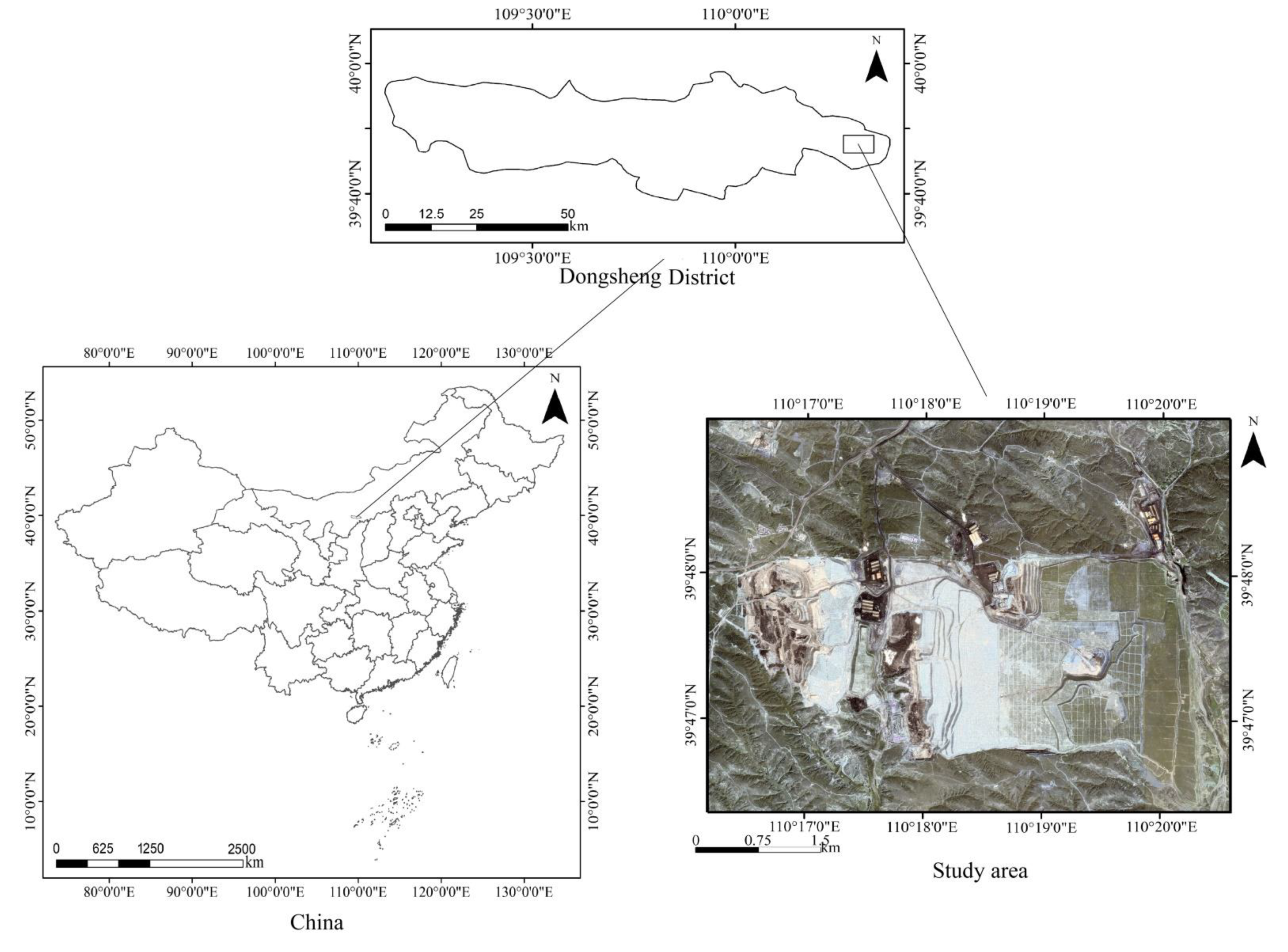
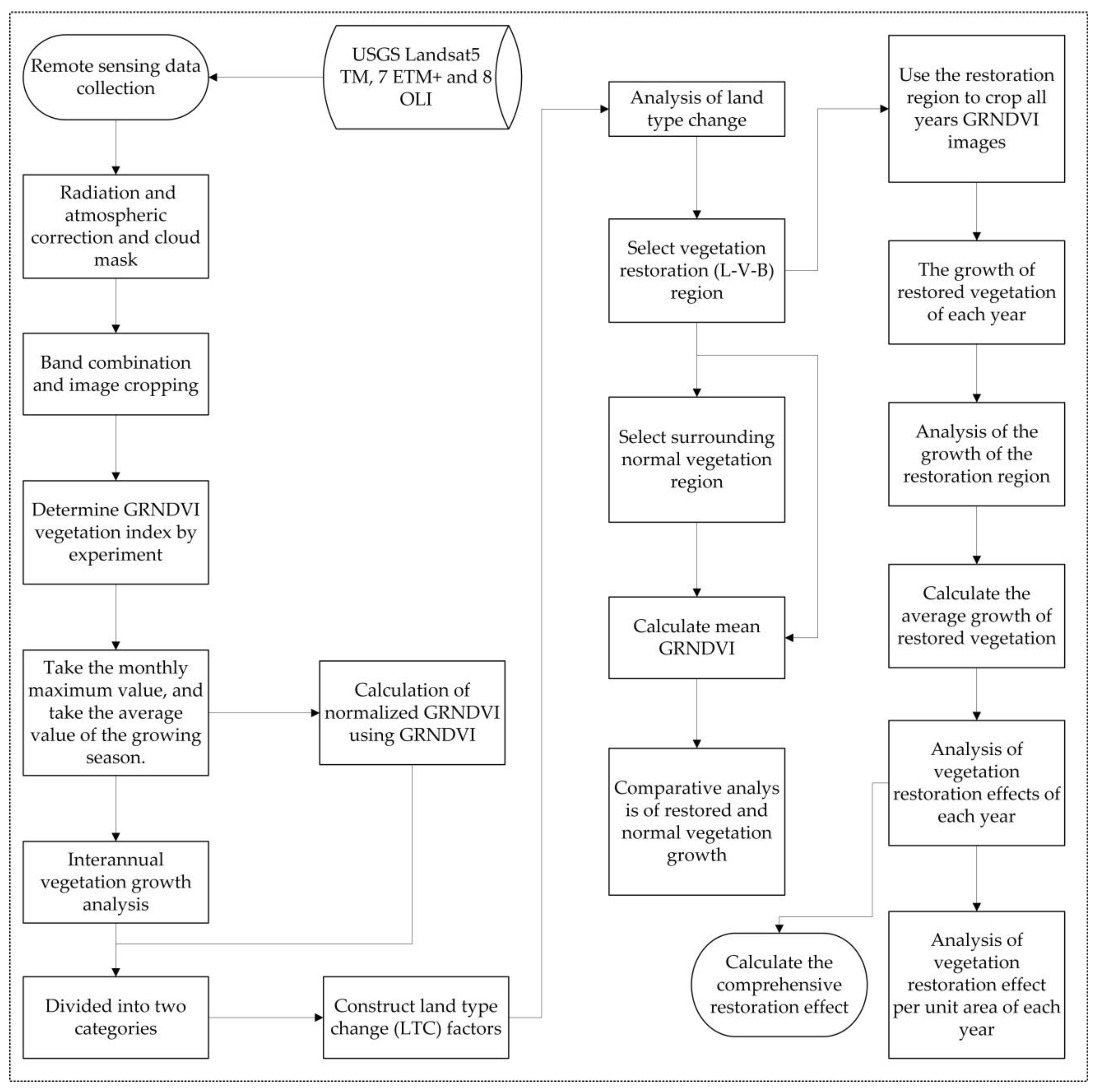

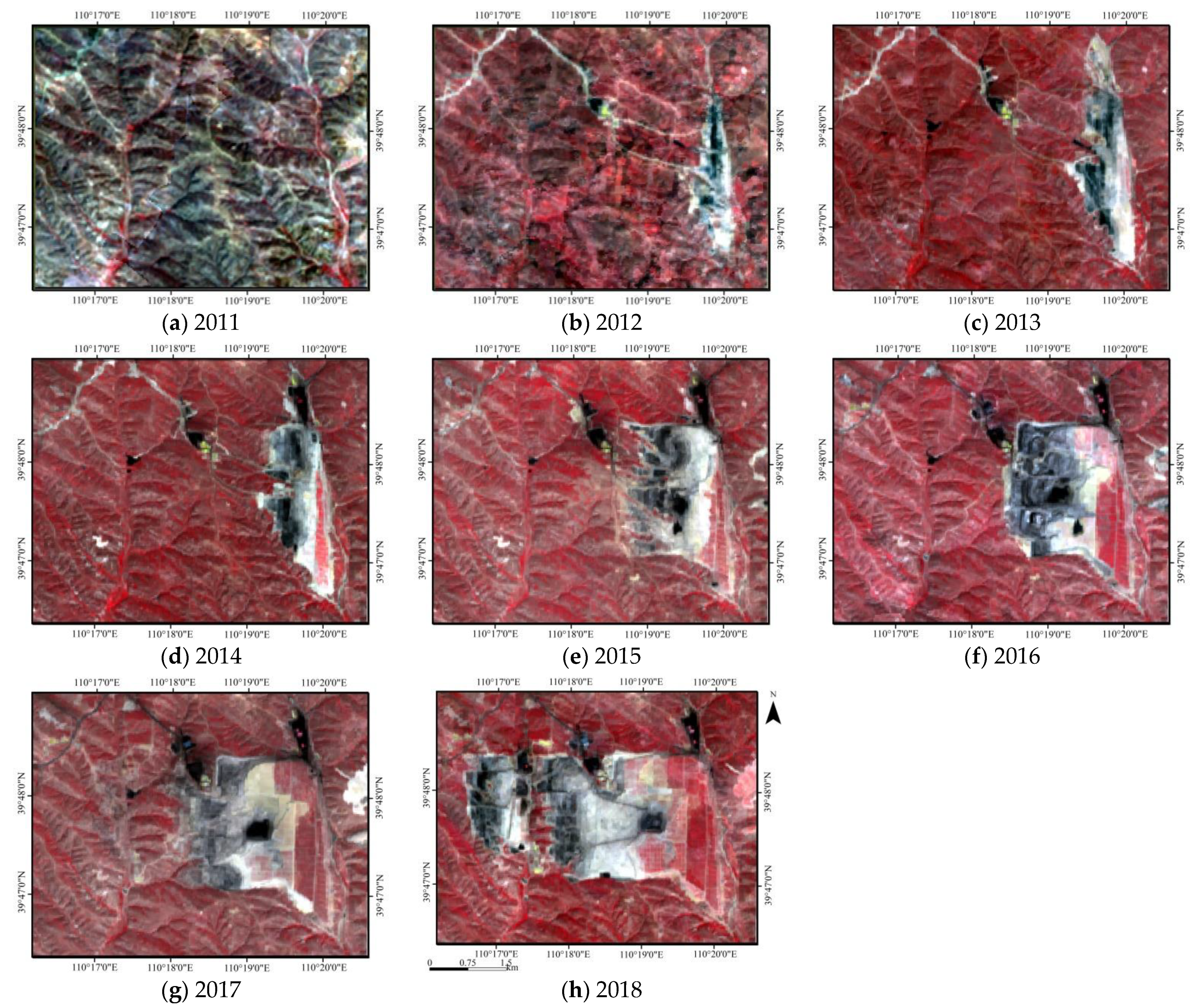
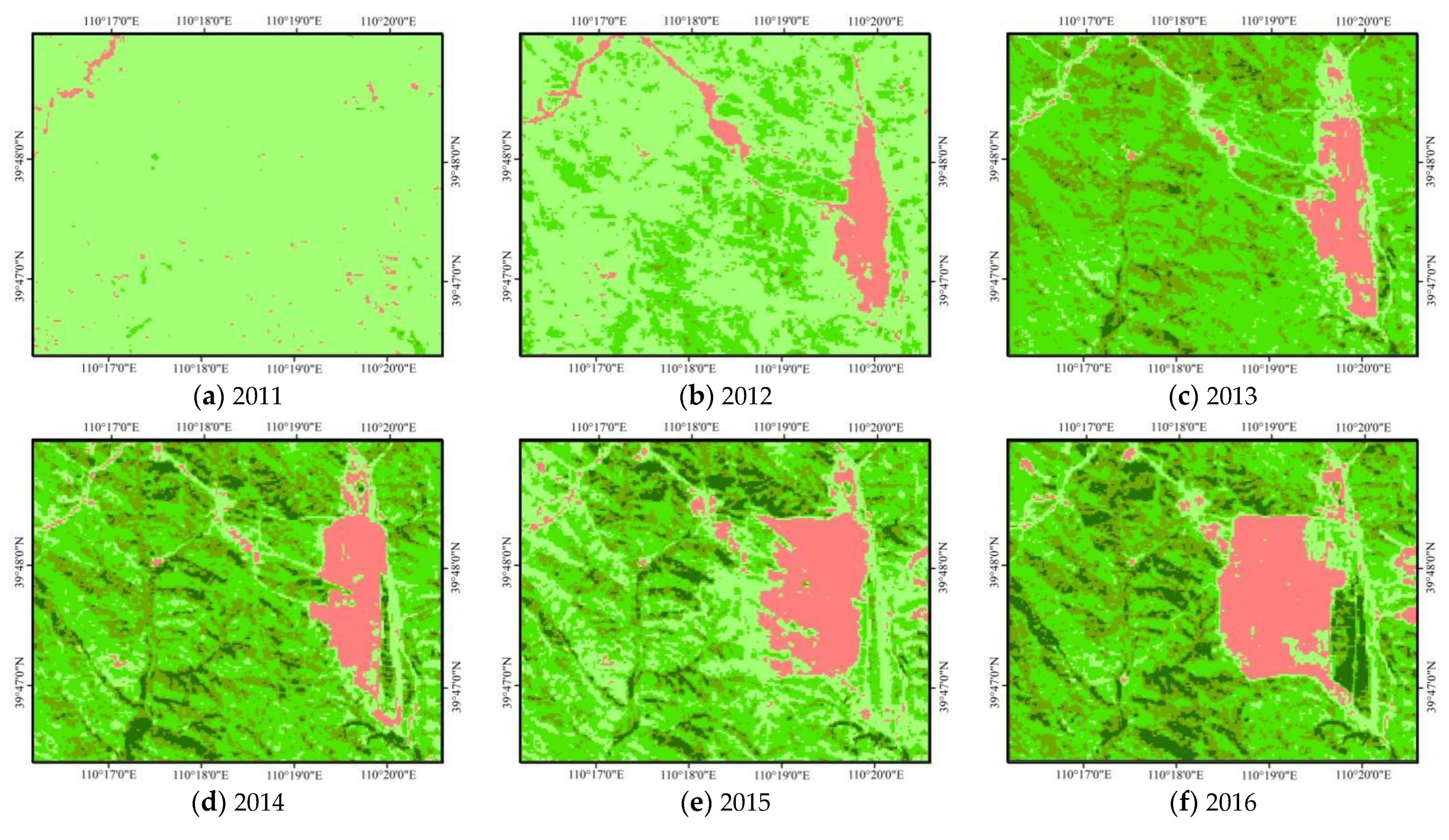


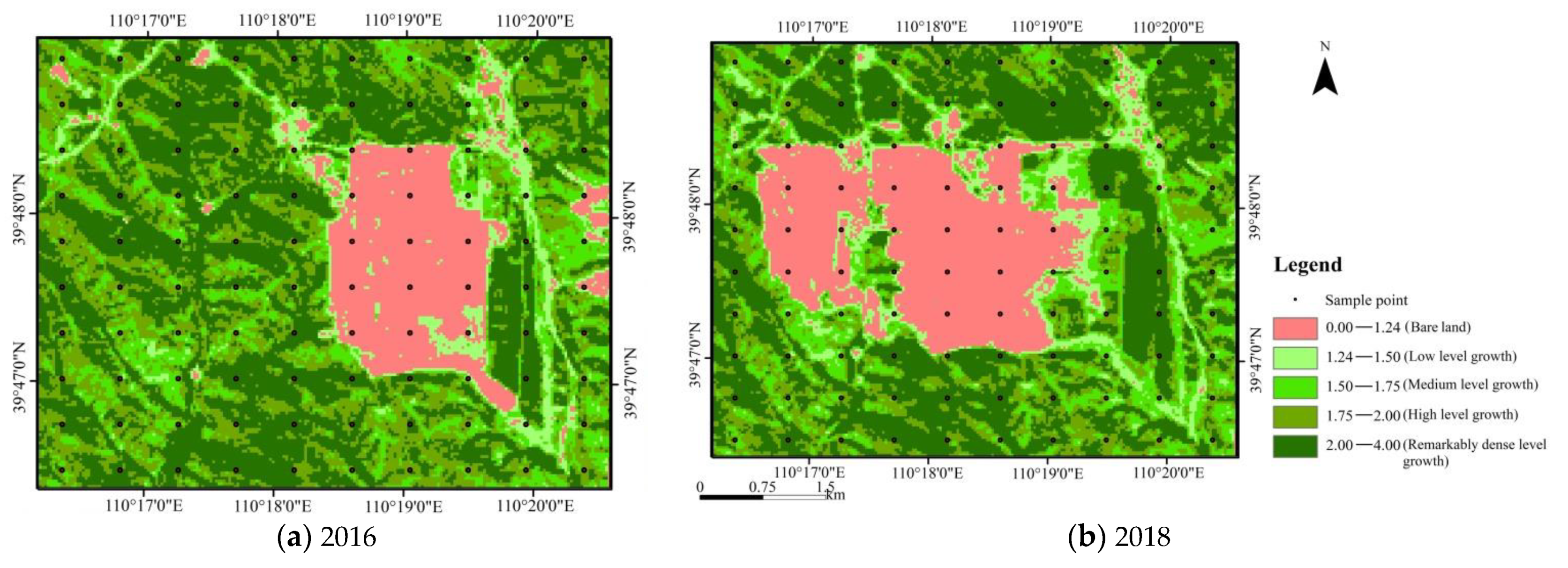



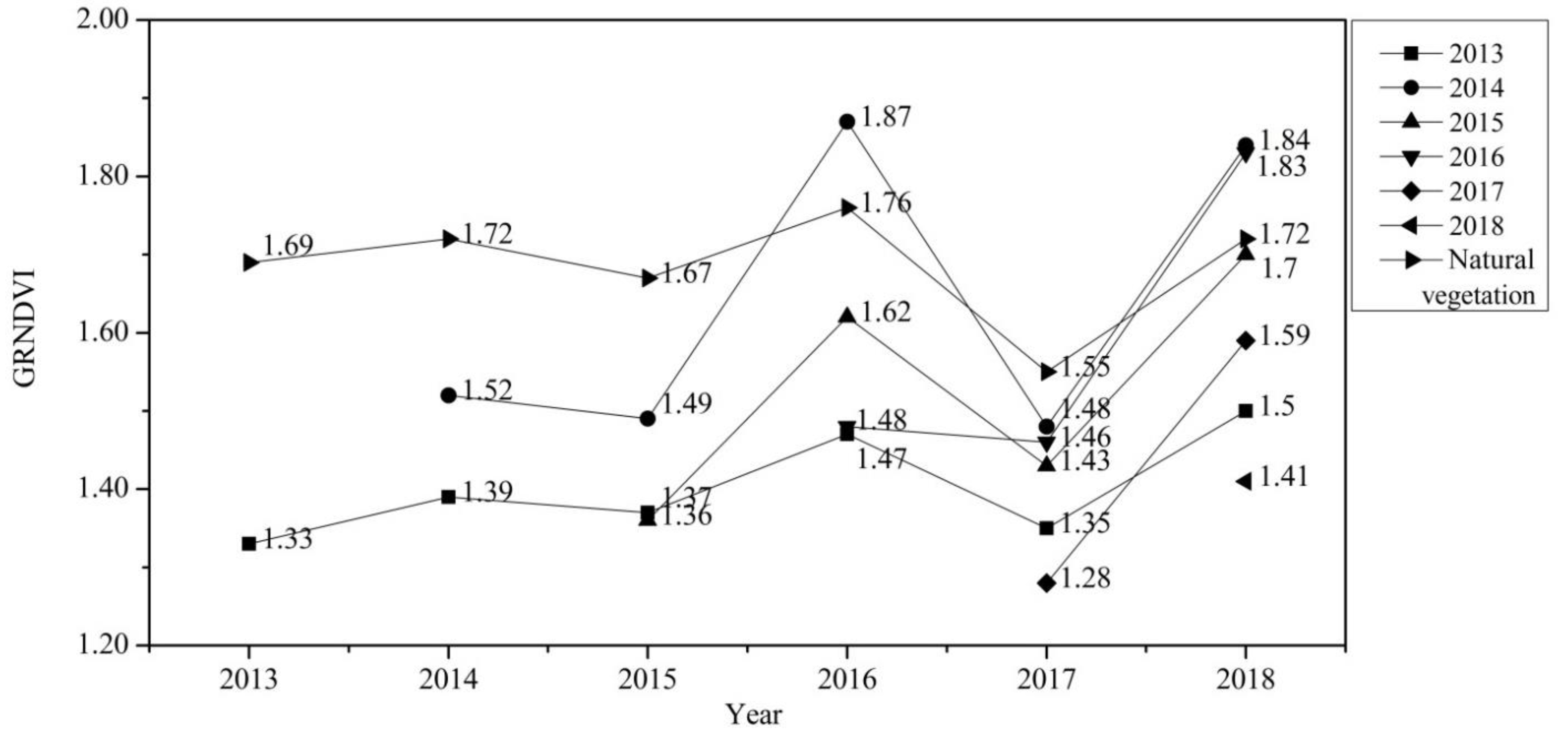

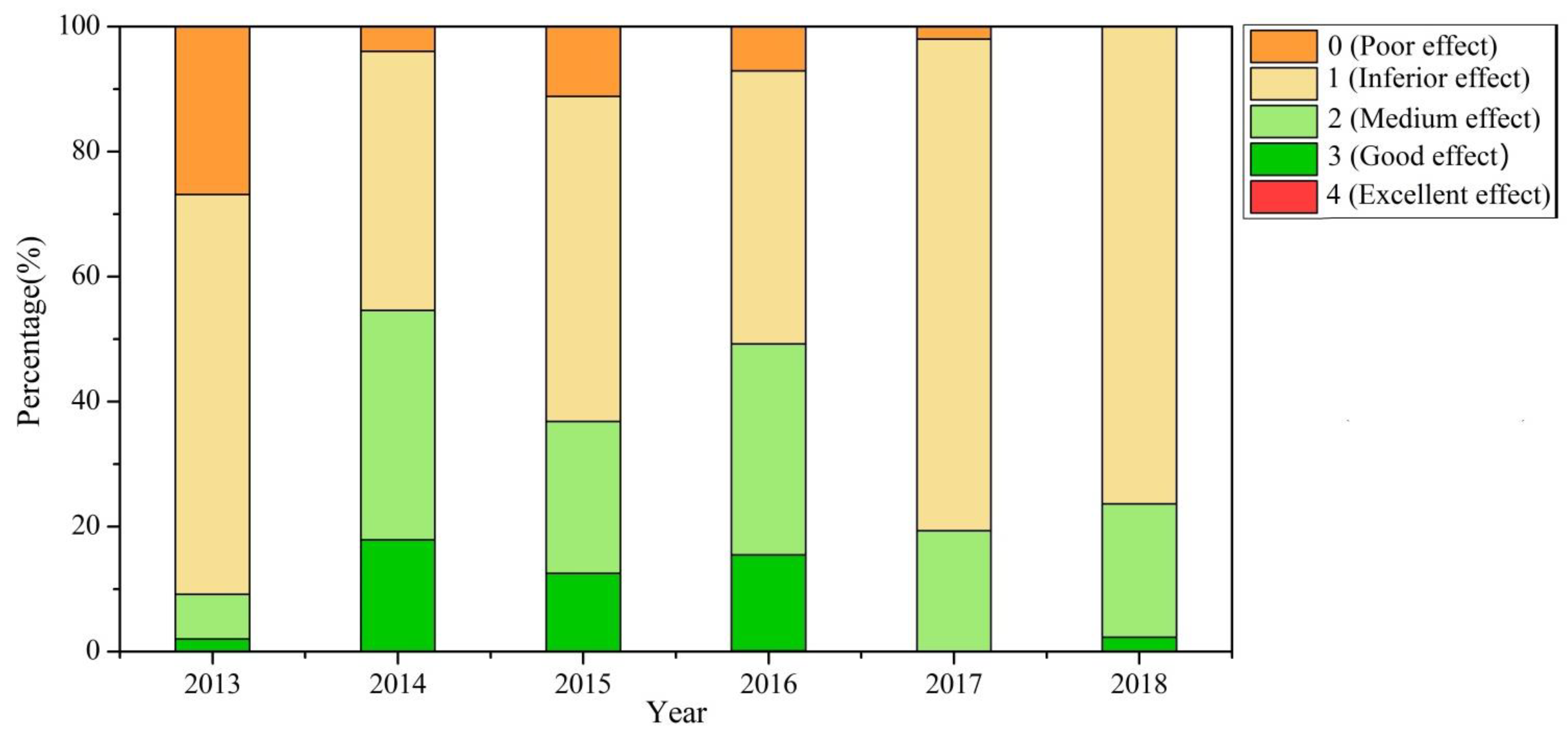
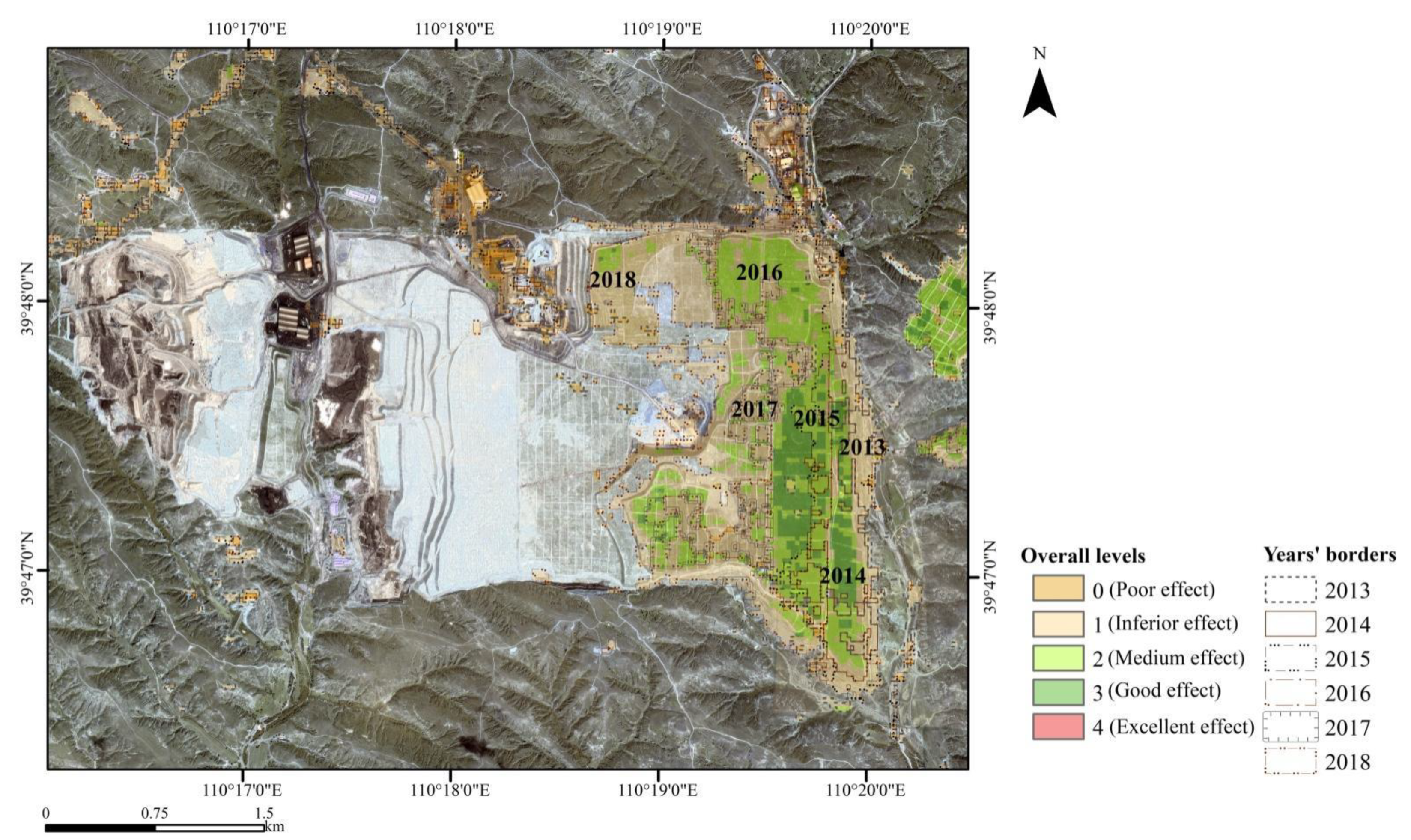
| Year | Image Number | Sensor and Image Date List |
|---|---|---|
| 2011 | 9 | TM: From 17 April 2011 to 24 September 2011 |
| 2012 | 9 | ETM+: From 27 April 2012 to 18 September 2012 |
| 2013 | 10 | OLI: From 3 April 2013 to 29 September 2013 |
| 2014 | 10 | OLI: From 9 April 2014 to 2 October 2014 |
| 2015 | 12 | OLI: From 12 April 2015 to 5 October 2015 |
| 2016 | 13 | OLI: From 14 April 2016 to 23 October 2016 |
| 2017 | 12 | OLI: From 1 April 2017 to 26 October 2017 |
| 2018 | 12 | OLI: From 20 April 2018 to 29 October 2018 |
| Sentinal 2 Image Data | Classification Result Date | Overall Accuracy |
|---|---|---|
| 19 May 2016 | 2016 | 93% |
| 7 August 2016 | 2016 | 92% |
| 26 October 2016 | 2016 | 94% |
| 24 May 2018 | 2018 | 92% |
| 28 June 2018 | 2018 | 93% |
| 11 October 2018 | 2018 | 91% |
Publisher’s Note: MDPI stays neutral with regard to jurisdictional claims in published maps and institutional affiliations. |
© 2021 by the authors. Licensee MDPI, Basel, Switzerland. This article is an open access article distributed under the terms and conditions of the Creative Commons Attribution (CC BY) license (https://creativecommons.org/licenses/by/4.0/).
Share and Cite
Wang, W.; Liu, R.; Gan, F.; Zhou, P.; Zhang, X.; Ding, L. Monitoring and Evaluating Restoration Vegetation Status in Mine Region Using Remote Sensing Data: Case Study in Inner Mongolia, China. Remote Sens. 2021, 13, 1350. https://doi.org/10.3390/rs13071350
Wang W, Liu R, Gan F, Zhou P, Zhang X, Ding L. Monitoring and Evaluating Restoration Vegetation Status in Mine Region Using Remote Sensing Data: Case Study in Inner Mongolia, China. Remote Sensing. 2021; 13(7):1350. https://doi.org/10.3390/rs13071350
Chicago/Turabian StyleWang, Wei, Rongyuan Liu, Fuping Gan, Ping Zhou, Xiangwen Zhang, and Ling Ding. 2021. "Monitoring and Evaluating Restoration Vegetation Status in Mine Region Using Remote Sensing Data: Case Study in Inner Mongolia, China" Remote Sensing 13, no. 7: 1350. https://doi.org/10.3390/rs13071350
APA StyleWang, W., Liu, R., Gan, F., Zhou, P., Zhang, X., & Ding, L. (2021). Monitoring and Evaluating Restoration Vegetation Status in Mine Region Using Remote Sensing Data: Case Study in Inner Mongolia, China. Remote Sensing, 13(7), 1350. https://doi.org/10.3390/rs13071350






